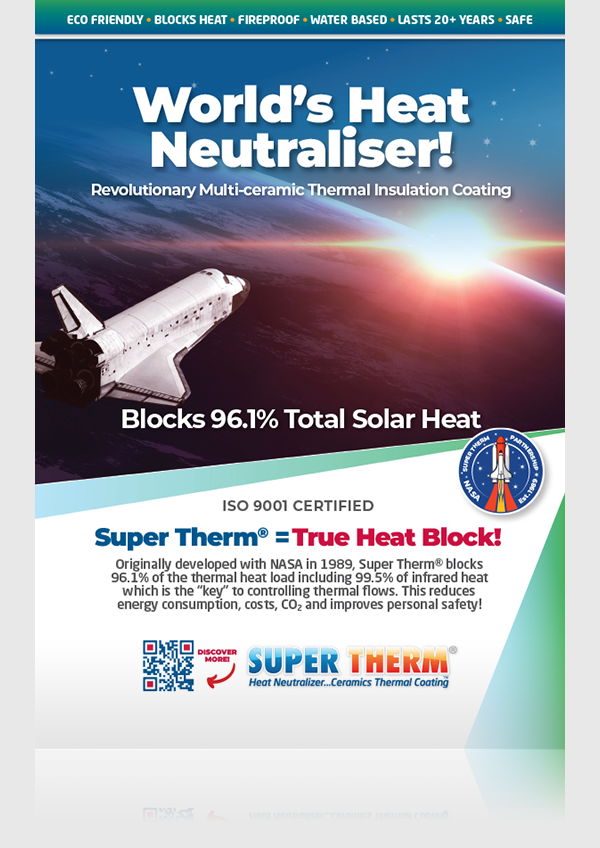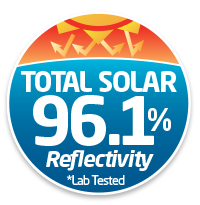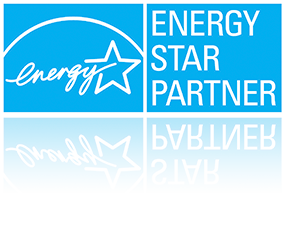ASTM C-236 Testing for “R” Ratings
Super Therm® C-236 Full Report
ASTM C-236 testing and interpretation
Super Therm® underwent ASTM C236 testing (Standard Test Method for Steady-State Thermal Performance of Building Assemblies by Means of a Guarded Hot Box) to compare its performance with conventional fibreglass insulation.
The key discovery is simple: an “R-value” represents a material’s ability to absorb and store heat before that heat transfers through the material. It suits bulk insulation that holds heat. Super Therm®, built from specialised ceramic compounds, does not absorb heat. It blocks and repels it. This makes the standard R-value framework a poor measure of its actual behaviour.
Test setup
The standard requires a 75mm/3 inch fibreglass board as the control assembly. Three samples were tested:
- 75mm bare fibreglass
- 75mm fibreglass with Super Therm® on one side
- 75mm fibreglass with Super Therm® on both sides
Results were recorded as heat conduction values.
Original unit: BTU/ft²/hr/°F
Metric equivalent: W/m²·K
(Conversions included below.)
Conductance results (metric)
| Panel | Original value | Metric value (W/m²·K) |
|---|---|---|
| Bare 75mm/3 inch fibreglass | 0.52 | ≈ 2.95 W/m²·K |
| One side coated | 0.31 | ≈ 1.76 W/m²·K |
| Two sides coated | 0.21 | ≈ 1.19 W/m²·K |
Lower is better. In all cases, Super Therm® improved performance dramatically, even at the 75°F (24°C) test temperature where fibreglass performs best. According to VTEC and National Certified Testing Laboratories, the improvement in thermal resistance when Super Therm® is applied over fibreglass increases significantly at temperatures above and below 24°C. Based on conductance testing and field studies, a single film of Super Therm® performs at a minimum equivalent of R-3.35 m²·K/W (the metric equivalent of R-19).
Temperature dependency
Fibreglass must be tested at 24°C because its thermal performance collapses above or below this point. Laboratories openly acknowledged this. Real-world temperatures rarely sit at 24°C, so the advertised R-values don’t hold up in practice.
Super Therm® doesn’t have this weakness. It maintains consistent insulation performance from –51°C to +49°C, verified across global field studies and ASTM testing.
Specific heat and diffusivity performance
In ASTM E1269 (specific heat) and ASTM E1461-92 (thermal diffusivity), Super Therm® reduced heat conduction from:
- 367.20 BTU/ft²/hr/°F → 3.99 BTU/ft²/hr/°F
Metric conversion:
- ≈ 2,083 W/m²·K → ≈ 22.6 W/m²·K
These values apply across steel, concrete, and other building substrates.
R-value comparison (metric context)
High-density fibreglass used in lab testing is rated around R-0.68 per mm (R-3.846 per inch).
So 75mm gives:
- R-11.5 (imperial) ≈ R-2.02 m²·K/W (metric)
Using the linear improvement from the conductance reductions:
- One-side coating
Improvement factor: 1.68- R-2.02 × 1.68 = R-3.39 m²·K/W
(Equivalent to roughly R19 imperial)
- R-2.02 × 1.68 = R-3.39 m²·K/W
- Two-side coating
Improvement factor: 2.47- R-2.02 × 2.47 = R-4.99 m²·K/W
(Equivalent to roughly R28–R30 imperial)
- R-2.02 × 2.47 = R-4.99 m²·K/W
These are minimums. Insulation effects compound, meaning true performance exceeds the simple linear calculation.
Why Super Therm®Insulation coating both sides works
Super Therm® on both sides prevents the substrate from acting as a heat sink. The surface no longer absorbs heat from either direction, so the substrate becomes part of the insulation system.
Ceramic response at higher temperatures
The 75°F (24°C) test underutilises Super Therm’s ceramic package. Its IR-blocking ceramics activate more aggressively at higher temperatures typical of roofs, metal cladding, and industrial surfaces. Performance increases as heat load increases.
Super Therm® contains four ceramic types engineered to block all major components of solar radiation—UV, visible, and infrared – across the full solar spectrum.
Certification
- Application by VTEC Laboratories, New York
- Testing by National Certified Testing Laboratories (NCTL), Pennsylvania, ASTM certified
- Commissioned originally for Bombardier (Mexico City) to replace fibreglass in passenger rail cars.
Takeaway
The guarded hot box test confirmed what the field has shown for decades: Super Therm® behaves as a true insulation material, but not in the way fibreglass does. R-value is based on heat absorption. Super Therm® blocks heat before it can load, which is why conventional metrics underestimate its real-world performance. This test was performed for the specific reason to prove that the Super Therm® is an insulation material used in the building and construction industry.









